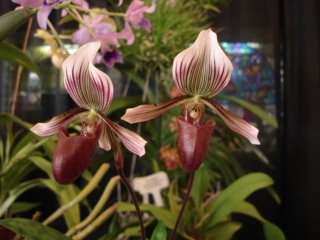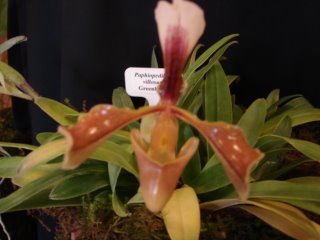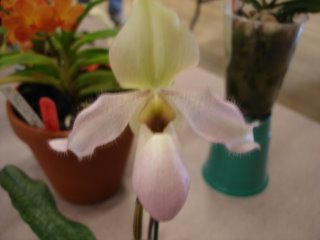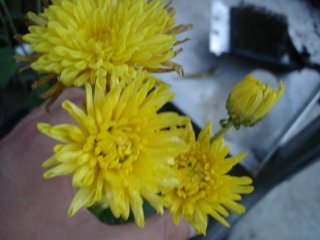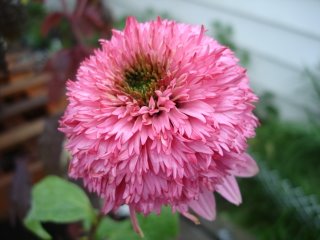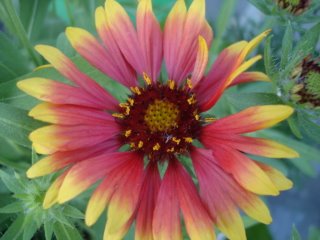The bird of paradise is a popular and well-known subtropical plant. Its exotic, orange flowers are unmistakable. In warm climates it's actually a common garden plant, and in cooler climates it makes a good houseplant, a patio plant during the summer. These plants are expensive blooming size but can sometimes be found cheaper as younger plants. Not only are they usually imported, but take at least 3-5 years from seed to reach marurity; this is the reason for their high prices. Seed is readily available but difficult to germinate.
As a houseplant, the bird of paradise likes bright light and as such makes a great heated sunroom plant. South and west windows work too. Outside it prefers full sun. It should be watered generously in the summer, less in winter. Bird of paradise does not like dry soil. Fertilizer should never be applied copiously as this causes excessive foliage and few flowers. However, the occasional feeding (every 2-3 weeks, less in winter) is needed. Use a balanced all-purpose formula. This plant likes to be potbound and as such should only be repotted if absolutely necessary. They seem to flower more in this state. Use a high quality potting soil mix or tropical mix. Bird of paradise usually flowers from late winter into summer, but they can bloom throughout the year. The flowers last several weeks.
There are three main bird of paradise species, Strelitzia reginae (common bird), S. alba (white bird) and S. nicolai (giant bird). A popular variety of S. reginae, 'Mandela's Gold', exists which has a compact habit and exceptionally bright flowers. Both S. alba and S. nicolai have larger, white flowers, and have a larger habit than S. reginae; S. nicolai grows much like a tree and can reach 30 feet in height. It obviously doesn't make a very good houseplant. S. reginae grows 3-4' tall and S. alba grows 5-6'. S. alba is commonly seen in nurseries, often mislabeled as S. nicolai. The distinguishing feature of S. nicolai is its tough trunk.
The easiest method of bird of paradise propagation is by divison. Only divide large, mature clumps. Divisons can take 1-2 years to bloom. Seed propagation is another method. You can buy a package of seeds pretty much anywhere for around $5, compared to prices of mature plants up to $250 that I've seen. However, seed propagation is a slow process that requires much patience. By no means is it as complex and skill-demanding as orchid seed propagtion, but it isn't like sowing sweet peas. The seeds are about the size of sweet pea seeds though, and have a hard covering, and an orange tuft of hairs on the end. They must have these tufts removed, then be soaked in lukewarm water for 24 hours, and scarified with a file or knife. At this point the seeds should be lightly pressed into a 1:1 mix of sand and potting soil, and kept moist and humid under a dome, in diminished light and at room temperature. They will take 1-3 months to germinate. Once the seedlings have 3 or 4 true leaves, they should be pricked out and planted in small pots of seedling mix. They should then be repotted as needed.
Sunday, December 31, 2006
Follow-up to Amaryllis Culture
Friday, December 29, 2006
Amaryllis (Hippeastrum) Culture

I wanted to do this at Christmas but never got down to it. Amaryllis have become popular plants to keep indoors at this time of the year. The Amaryllis I refer to are not true Amaryllis, but are rather members of the genus Hippeastrum. However, they closely resemble Amaryllis.
You usually buy Amaryllis in the form of a planting kit which includes a bulb, pot and soil, complete with planting instructions. It's also common to see them as potted plants. The care of these plants is quite simple, but few people know how to keep them as perennials and most often throw them out after flowering.
Care before flowering
When you pot the plant you should plant the bulb so that the neck is above the soil surface, and the part where the bulb starts to round is just below the surface. Amaryllis are prone to rot at the neck, where water can get lodged in the bracts from previous growths. This is why it must not be under the soil. After potting, the soil shoild be kept barely moist. It is probably best to water from the bottom to keep the neck dry. Amaryllis roots grow from the bottom of the bulb; this is the only part of the plant that likes water. The plant should not be watered until the soil has dried to this point; check with a toothpick. As far as light goes, the plant doesn't need bright light at this point because it won't really grow leaves until after flowering. In fact, bright light will produce small flowers or none at all. As for fertilizer, don't until after flowering. And temperature - standard room temps. 20-25C is ideal (during the day), with a 5C difference day-night. Temps down to 10C at night can be tolerated; I recommend around 15C. These conditions are easy to achieve in the home. Six to eight weeks after planting, your plant will flower. You'll notice a thick, hollow stalk topped with a large "bud" appear and grow over time, perhaps along with some leaves (which very seldom fully develop before flowers) or another bud (or two or three). This "bud" will eventually open to reveal several true buds. As the plant ages, more flower stems will develop every season. Each lasts nearly two weeks and they usually open in succession, so the older the bulb the longer the season.
Care after flowering
After flowering, the plant will produce one or more fans of long leaves. The plant makes an attractive houseplant even when not flowering. It should stay green for several months, entering dormancy around August or September (providing it flowered in December or January). In the house (while it's still cold outside), place it near a sunny window, but avoid direct sun. Water in the same way as before, and fertilize every two weeks with a balanced all-purpose formula. In June the plant can be put outside (and should be) to enjoy fresh air and natural temperatures. Keep it in a dappled shady location. Bring it inside before first frost, but it will likely lose its leaves before then. At this point the pot should be dried out and put in a cool place (5-10C) for at least 6 weeks. You can also un-pot the plant and place the bulb in a sealed poly bag, in the crisper drawer of a refrigerator. Keep it dry during dormancy. Note that the bulb should never be frozen! After six weeks have passed, you have the option of repotting the plant and following care before flowering. Remember to pot 6-8 weeks before you want it to flower.
You usually buy Amaryllis in the form of a planting kit which includes a bulb, pot and soil, complete with planting instructions. It's also common to see them as potted plants. The care of these plants is quite simple, but few people know how to keep them as perennials and most often throw them out after flowering.
Care before flowering
When you pot the plant you should plant the bulb so that the neck is above the soil surface, and the part where the bulb starts to round is just below the surface. Amaryllis are prone to rot at the neck, where water can get lodged in the bracts from previous growths. This is why it must not be under the soil. After potting, the soil shoild be kept barely moist. It is probably best to water from the bottom to keep the neck dry. Amaryllis roots grow from the bottom of the bulb; this is the only part of the plant that likes water. The plant should not be watered until the soil has dried to this point; check with a toothpick. As far as light goes, the plant doesn't need bright light at this point because it won't really grow leaves until after flowering. In fact, bright light will produce small flowers or none at all. As for fertilizer, don't until after flowering. And temperature - standard room temps. 20-25C is ideal (during the day), with a 5C difference day-night. Temps down to 10C at night can be tolerated; I recommend around 15C. These conditions are easy to achieve in the home. Six to eight weeks after planting, your plant will flower. You'll notice a thick, hollow stalk topped with a large "bud" appear and grow over time, perhaps along with some leaves (which very seldom fully develop before flowers) or another bud (or two or three). This "bud" will eventually open to reveal several true buds. As the plant ages, more flower stems will develop every season. Each lasts nearly two weeks and they usually open in succession, so the older the bulb the longer the season.
Care after flowering
After flowering, the plant will produce one or more fans of long leaves. The plant makes an attractive houseplant even when not flowering. It should stay green for several months, entering dormancy around August or September (providing it flowered in December or January). In the house (while it's still cold outside), place it near a sunny window, but avoid direct sun. Water in the same way as before, and fertilize every two weeks with a balanced all-purpose formula. In June the plant can be put outside (and should be) to enjoy fresh air and natural temperatures. Keep it in a dappled shady location. Bring it inside before first frost, but it will likely lose its leaves before then. At this point the pot should be dried out and put in a cool place (5-10C) for at least 6 weeks. You can also un-pot the plant and place the bulb in a sealed poly bag, in the crisper drawer of a refrigerator. Keep it dry during dormancy. Note that the bulb should never be frozen! After six weeks have passed, you have the option of repotting the plant and following care before flowering. Remember to pot 6-8 weeks before you want it to flower.
The picture at top is of my Hippeastrum Hadeco 'Symphony Red' as it appeared a couple days ago.
Phragmipedium schlimii New Photo
Cymbidium Gung Hey Fat Choy 'Murasaki Gengi'
Monday, December 25, 2006
Phragmipedium kovachii Culture Notes
I attended Peter Croezen's presentation on this amazing plant last week and the following is what I learned.
Light
Seedlings must have low light at 400-450 footcandles. Higher light will cause fatal leaf yellowing.
Water
Use pure water (such as distilled, rain or RO). Keep moist but not soggy. They really like growing their roots into water; using PrimeAgra creates an environment that keeps the roots very moist but not too soggy.
Fertilizer
Use a mineral-rich fertilizer at 200ppm every week. Calcium, magnesium and boron are important.
Temperature
Keep a relatively constant temp. of 20C. Higher temps (above 24C) will cause fatal leaf yellowing.
Media
As newly deflasked seedlings, pot into a small 2" container, in sphagnum moss, and keep moist. When a considerable rootball is developed, pot up, into PrimeAgra or bark.
I have ordered a Pk seedling from Mr. Croezen.
Light
Seedlings must have low light at 400-450 footcandles. Higher light will cause fatal leaf yellowing.
Water
Use pure water (such as distilled, rain or RO). Keep moist but not soggy. They really like growing their roots into water; using PrimeAgra creates an environment that keeps the roots very moist but not too soggy.
Fertilizer
Use a mineral-rich fertilizer at 200ppm every week. Calcium, magnesium and boron are important.
Temperature
Keep a relatively constant temp. of 20C. Higher temps (above 24C) will cause fatal leaf yellowing.
Media
As newly deflasked seedlings, pot into a small 2" container, in sphagnum moss, and keep moist. When a considerable rootball is developed, pot up, into PrimeAgra or bark.
I have ordered a Pk seedling from Mr. Croezen.
Saturday, December 23, 2006
New Acquisition
I've developed a tradition of buying a "Christmas Orchid" every year. Last year this was Paph. (Valerie Tonkin x Maudiae). This year it's Cymbidium Un-named Cultivar 'Murasaki Gengi'. I'll be posting photos today.
Wednesday, December 20, 2006
Pictures on the Front Page
I've decorated the front page with some of my most-wanted slipper orchids. As they are acquired they will be replaced with my own photos.
Tuesday, December 19, 2006
2006 Year End Current Orchid List & Wanted List
Current List, with price paid for each:
Bletilla striata 1 $2
Bletilla striata 2 $2
Bletilla striata 3 $2
Bletilla striata 4 $2
Brassia Eternal Wind 'Summer Dream' $35
Cypripedium calceolus (?) $25
Cypripedium macranthos $25
Cypripedium parviflorum var. parviflorum $10
Cypripedium parviflorum var. pubescens 1 $25
Cypripedium parviflorum var. pubescens 2 $25
Cypripedium parviflorum var. pubescens 3 $20
Cypripedium parviflorum var. pubescens 4 $40
Cypripedium reginae 1 $30
Cypripedium reginae 2 $25
Cypripedium Ulla Silkens $60
Dactylorhiza purpurella $25
Dendrobium kingianum $20
Dendrobium unknown seedling $0
Doritaenopsis (Dtps. Taisuco Okay Stripe x Phal. amabilis) $20
Odontoglossum Tiger Crow 'Golden Girl' (?) $20
Odontoglossum Violetta von Holm 'Dominique' $30
Odontonia Memoria Martin Orenstein 'Lulu' HCC/AOS $30
Paphiopedilum (Carticle x Hsinying Maru) $40
Paphiopedilum (Claire de Lune x philippinense var. alba) $50
Paphiopedilum delenatii ('Jingle Bells' x 'Dark & Flat') $35
Paphiopedilum Ho Chi Minh $30
Paphiopedilum insigne 1 $10
Paphiopedilum insigne 2 $10
Paphiopedilum (Joyce Hasegawa x chamberlainianum) $30
Paphiopedilum (Ruby Peacock x Hampshire Raven) $50
Paphiopedilum (Valerie Tonkin x Maudiae) $55
Paphiopedilum (Yerba Buena x Golden Days) x spicerianum $30
Paphiopedilum (Z4135 x charlesworthii) $50
Phalaenopsis Maki Watanabe $30
Phragmipedium besseae ('Fire Engine' x 'First Choice') $45
Phragmipedium Ecua-bess $35
Phragmipedium Grande $65
Phragmipedium Saint Ouen $25
Phragmipedium schlimii $20
Total = 39 orchids, $1083 spent
Wanted List (In no particular order), bolded = most wanted:
(includes maximum value estimated)
Paphiopedilum micranthum $80
Phragmipedium fischeri $80
Phragmipedium kovachii $200
Phragmipedium Hanne Popow $50
Phragmipedium schlimii 'Wilcox' AM/AOS (Cardinale) $80
Paphiopedilum Magic Lantern $45
Cypripedium montanum $90
Cypripedium acaule $35
Cypripedium x andrewsii $80
Cypripedium Gisela $60
Cypripedium formosanum $45
Phragmipedium Ruby Slippers $55
Cypripedium kentuckiense $35
Paphiopedilum Armeni-white $45
Paphiopedilum villosum $45
Cypripedium Inge $60
Mexipedium xerophyticum $80
I also really want a couple complex paphs, one in red/pink shades and one in copper/orange/yellow shades (perhaps a white one too).
Bletilla striata 1 $2
Bletilla striata 2 $2
Bletilla striata 3 $2
Bletilla striata 4 $2
Brassia Eternal Wind 'Summer Dream' $35
Cypripedium calceolus (?) $25
Cypripedium macranthos $25
Cypripedium parviflorum var. parviflorum $10
Cypripedium parviflorum var. pubescens 1 $25
Cypripedium parviflorum var. pubescens 2 $25
Cypripedium parviflorum var. pubescens 3 $20
Cypripedium parviflorum var. pubescens 4 $40
Cypripedium reginae 1 $30
Cypripedium reginae 2 $25
Cypripedium Ulla Silkens $60
Dactylorhiza purpurella $25
Dendrobium kingianum $20
Dendrobium unknown seedling $0
Doritaenopsis (Dtps. Taisuco Okay Stripe x Phal. amabilis) $20
Odontoglossum Tiger Crow 'Golden Girl' (?) $20
Odontoglossum Violetta von Holm 'Dominique' $30
Odontonia Memoria Martin Orenstein 'Lulu' HCC/AOS $30
Paphiopedilum (Carticle x Hsinying Maru) $40
Paphiopedilum (Claire de Lune x philippinense var. alba) $50
Paphiopedilum delenatii ('Jingle Bells' x 'Dark & Flat') $35
Paphiopedilum Ho Chi Minh $30
Paphiopedilum insigne 1 $10
Paphiopedilum insigne 2 $10
Paphiopedilum (Joyce Hasegawa x chamberlainianum) $30
Paphiopedilum (Ruby Peacock x Hampshire Raven) $50
Paphiopedilum (Valerie Tonkin x Maudiae) $55
Paphiopedilum (Yerba Buena x Golden Days) x spicerianum $30
Paphiopedilum (Z4135 x charlesworthii) $50
Phalaenopsis Maki Watanabe $30
Phragmipedium besseae ('Fire Engine' x 'First Choice') $45
Phragmipedium Ecua-bess $35
Phragmipedium Grande $65
Phragmipedium Saint Ouen $25
Phragmipedium schlimii $20
Total = 39 orchids, $1083 spent
Wanted List (In no particular order), bolded = most wanted:
(includes maximum value estimated)
Paphiopedilum micranthum $80
Phragmipedium fischeri $80
Phragmipedium kovachii $200
Phragmipedium Hanne Popow $50
Phragmipedium schlimii 'Wilcox' AM/AOS (Cardinale) $80
Paphiopedilum Magic Lantern $45
Cypripedium montanum $90
Cypripedium acaule $35
Cypripedium x andrewsii $80
Cypripedium Gisela $60
Cypripedium formosanum $45
Phragmipedium Ruby Slippers $55
Cypripedium kentuckiense $35
Paphiopedilum Armeni-white $45
Paphiopedilum villosum $45
Cypripedium Inge $60
Mexipedium xerophyticum $80
I also really want a couple complex paphs, one in red/pink shades and one in copper/orange/yellow shades (perhaps a white one too).
Planting Cypripediums, Volume 3
In this third and final volume I'd like to discuss care after planting, on a seasonal basis.
Spring
In the spring Cyps will emerge from the ground after the dormant period and almost immediately begin flowering. Remove any mulch after last frost. It takes about 2 weeks to completely unravel the leaves and open the flowers. The flowers will last for another 2-3 weeks. Different Cyps have slightly different times at which they emerge and flower, and different rates at which they grow. At this time you want to fertilize lightly, using half strength orchid food every two weeks or so. Remember not to let the soil dry out completely, with the exception of C. acaule, which only ever needs to be watered in drought years (unless you need to adjust the pH with vinegar solution). If you want cut flowers, cut as short as possible and only on large established clumps; it weakens the plant.
Summer
After flowering, Cyps enter their active growth phase. You can't tell from above ground, but underground the plant is producing new roots and next year's growth buds. During this time they need the most fertilizer (especially hybrids and reginae). For hybrids and reginae, use Miracle-Gro or comparable product as for perennials; for all others use the half strength orchid food every week. It is also advisable at this time to mulch with organic content; this enriches the soil and keeps it cool and moist (don't do this for C. acaule and NEVER fertilize it! Mulch with conifer needles instaed).
Fall
As the weather changes the Cyps will begin to enter their dormant phase. The leaves will turn yellow, then brown (some just turn brown). Once the growths are completely dead, you may remove them if desired. If you are lucky you may have some seed pods on flowered growths; if so you can either leave them to disperse the seeds naturally, or spread the seeds over the ground yourself. Perhaps one day I'll create a post explaining how to sow seeds in the lab... doing it the natural way will get you flowering plants in 10-16 years if you're lucky. Now mulch with a few inches of dead leaves for winter protection.
Winter
During the winter Cyps have their dormant period. If you're growing in containers, keep the plant in the crisper drawer of a fridge for at least 3 months, BARELY damp.
Happy growing; this concludes Planting Cypripediums!
Spring
In the spring Cyps will emerge from the ground after the dormant period and almost immediately begin flowering. Remove any mulch after last frost. It takes about 2 weeks to completely unravel the leaves and open the flowers. The flowers will last for another 2-3 weeks. Different Cyps have slightly different times at which they emerge and flower, and different rates at which they grow. At this time you want to fertilize lightly, using half strength orchid food every two weeks or so. Remember not to let the soil dry out completely, with the exception of C. acaule, which only ever needs to be watered in drought years (unless you need to adjust the pH with vinegar solution). If you want cut flowers, cut as short as possible and only on large established clumps; it weakens the plant.
Summer
After flowering, Cyps enter their active growth phase. You can't tell from above ground, but underground the plant is producing new roots and next year's growth buds. During this time they need the most fertilizer (especially hybrids and reginae). For hybrids and reginae, use Miracle-Gro or comparable product as for perennials; for all others use the half strength orchid food every week. It is also advisable at this time to mulch with organic content; this enriches the soil and keeps it cool and moist (don't do this for C. acaule and NEVER fertilize it! Mulch with conifer needles instaed).
Fall
As the weather changes the Cyps will begin to enter their dormant phase. The leaves will turn yellow, then brown (some just turn brown). Once the growths are completely dead, you may remove them if desired. If you are lucky you may have some seed pods on flowered growths; if so you can either leave them to disperse the seeds naturally, or spread the seeds over the ground yourself. Perhaps one day I'll create a post explaining how to sow seeds in the lab... doing it the natural way will get you flowering plants in 10-16 years if you're lucky. Now mulch with a few inches of dead leaves for winter protection.
Winter
During the winter Cyps have their dormant period. If you're growing in containers, keep the plant in the crisper drawer of a fridge for at least 3 months, BARELY damp.
Happy growing; this concludes Planting Cypripediums!
Monday, December 18, 2006
Planting Cypripediums: Volume 2
This second of three volumes is on soil mixes and hardiness for individual species and hybrids.
The most common Cyp. species are C. acaule, C. calceolus, C. formosanum, C. kentuckiense, C. macranthos, C. montanum, C. parviflorum, C. reginae, and C. tibeticum. The most common hybrids are C. Aki, C. Emil, C. Gisela, C. Hank Small, C. Inge, C. Ingrid, C. Maria, C. Michael, C. Philip, and C. Ulla Silkens. Hybrids grow pretty much the same; species have individual needs.
C. acaule requires a very acidic soil, pH 3.5-5. I recommend spreading the roots over sand and covering in pine mulch, then watering sparingly with a solution of pure water and vinegar, at a rate of 1 ounce vinegar per gallon water. Hardy to zone 2.
C. calceolus should not be confused with our native yellow lady's slipper (C. parviflorum). I am referring to the European clone. A pH of 7-8 is necessary, with perfectly-drained soil. Use a balanced mix with loam, sand and gravel. Hardy to zone 3.
C. formosanum makes a great potted plant if it isn't hardy to your region. Known as an easy species, it prefers a pH of 6-7, in a well-drained soil. Always add drainage material in the bottom in the pot. Hardy to zone 6.
C. kentuckiense is just beginning to gain popularity. It is sought-after for its large flowers (largest in the genus). It likes a sandy soil with a pH of 5-6. I recommend using mostly sand with a little loam and a top-dressing of conifer mulch. Hardy to zone 3.
C. macranthos is very popular for its showy flowers in shades of pink, purple and red. It must have a prefectly-drained soil; use a well-balanced mix with loam, sand and gravel; pH around 7. Hardy to zone 2.
C. montanum is sought-after by collectors but has a reputation of being difficult to grow. It must have a sharply drained soil with plenty of gravel and sand, pH 7-8. I recommend planting on a slope. Hardy to zone 2.
C. parviflorum is the most common Cyp. It is easy to grow in a well-drained soil, pH 6-7. Hardy to zone 2.
C. reginae is the most majestic of the Cyps and is highly sought-after. It is relatively easy to grow in a well-drained soil, pH 7-8. Likes lots of moisture (NEVER wet!) and fertilizer. Hardy to zone 3.
C. tibeticum is a collector's species that is closely allied to C. macranthos but has darker maroon flowers. It requires perfect drainage, pH around 7. I'm unsure about hardiness but it has been grown in zone 3.
All hybrids like well-drained soil and lots of fertilizer, pH around 7. They're all hardy to at least zone 3.
The third and final volume will be about care after planting.
The most common Cyp. species are C. acaule, C. calceolus, C. formosanum, C. kentuckiense, C. macranthos, C. montanum, C. parviflorum, C. reginae, and C. tibeticum. The most common hybrids are C. Aki, C. Emil, C. Gisela, C. Hank Small, C. Inge, C. Ingrid, C. Maria, C. Michael, C. Philip, and C. Ulla Silkens. Hybrids grow pretty much the same; species have individual needs.
C. acaule requires a very acidic soil, pH 3.5-5. I recommend spreading the roots over sand and covering in pine mulch, then watering sparingly with a solution of pure water and vinegar, at a rate of 1 ounce vinegar per gallon water. Hardy to zone 2.
C. calceolus should not be confused with our native yellow lady's slipper (C. parviflorum). I am referring to the European clone. A pH of 7-8 is necessary, with perfectly-drained soil. Use a balanced mix with loam, sand and gravel. Hardy to zone 3.
C. formosanum makes a great potted plant if it isn't hardy to your region. Known as an easy species, it prefers a pH of 6-7, in a well-drained soil. Always add drainage material in the bottom in the pot. Hardy to zone 6.
C. kentuckiense is just beginning to gain popularity. It is sought-after for its large flowers (largest in the genus). It likes a sandy soil with a pH of 5-6. I recommend using mostly sand with a little loam and a top-dressing of conifer mulch. Hardy to zone 3.
C. macranthos is very popular for its showy flowers in shades of pink, purple and red. It must have a prefectly-drained soil; use a well-balanced mix with loam, sand and gravel; pH around 7. Hardy to zone 2.
C. montanum is sought-after by collectors but has a reputation of being difficult to grow. It must have a sharply drained soil with plenty of gravel and sand, pH 7-8. I recommend planting on a slope. Hardy to zone 2.
C. parviflorum is the most common Cyp. It is easy to grow in a well-drained soil, pH 6-7. Hardy to zone 2.
C. reginae is the most majestic of the Cyps and is highly sought-after. It is relatively easy to grow in a well-drained soil, pH 7-8. Likes lots of moisture (NEVER wet!) and fertilizer. Hardy to zone 3.
C. tibeticum is a collector's species that is closely allied to C. macranthos but has darker maroon flowers. It requires perfect drainage, pH around 7. I'm unsure about hardiness but it has been grown in zone 3.
All hybrids like well-drained soil and lots of fertilizer, pH around 7. They're all hardy to at least zone 3.
The third and final volume will be about care after planting.
Sunday, December 17, 2006
Planting Cypripediums, Volume 1
I'm starting "volumes" or series of orchid information posts which I hope will become valuable Internet resources for people who share the same love I do. My first series is for planting Cypripediums, the genus of orchids I started with. Cyps (short form) are slipper orchids of the northern hemisphere, most of which are temperate zone inhabitants. In this first of three volumes I will discuss preparing the planting area.
Most species and hybrids prefer light shade, as you would get at woodland egdes. They need diffuse light to bloom, but too much direct sun easily scorches the leaves (even here in zone 3). Choose an area with such lightinng conditions, outside unless you are growing a variety which is not hardy to your region (not likely; in volume 2 I'll include a list of common species and their hardiness). Secondly, most Cyps need a lot of room to expand their rhizomes, because they will (or at least should) be left undisturbed here for many years. Over time they'll form large clumps, and they don't tolerate competition. Most species and hybrids should have a hole about 16" deep and at least 12" wide. Granted Cyp roots are quite shallow, they should still have a deep hole for lots of drainage material at the bottom. Note that vigorous hybrids and large species like reginae need wider holes to accommodate their large rootstocks.
With the hole dug, line it with landscape fabric to keep weeds out and add 10" of drainage material. The roots of the plant only need 6" of soil on top of this. Add 2-3" of the soil mix to the drainage layer, then spread the roots over this horizontally and fill the hole, without patting down. Then water thoroughly. The tips of the growth buds (on dormant plants) should be about an inch below the soil surface.
The next volume will be on species/hybrid hardiness and soil composition.
Most species and hybrids prefer light shade, as you would get at woodland egdes. They need diffuse light to bloom, but too much direct sun easily scorches the leaves (even here in zone 3). Choose an area with such lightinng conditions, outside unless you are growing a variety which is not hardy to your region (not likely; in volume 2 I'll include a list of common species and their hardiness). Secondly, most Cyps need a lot of room to expand their rhizomes, because they will (or at least should) be left undisturbed here for many years. Over time they'll form large clumps, and they don't tolerate competition. Most species and hybrids should have a hole about 16" deep and at least 12" wide. Granted Cyp roots are quite shallow, they should still have a deep hole for lots of drainage material at the bottom. Note that vigorous hybrids and large species like reginae need wider holes to accommodate their large rootstocks.
With the hole dug, line it with landscape fabric to keep weeds out and add 10" of drainage material. The roots of the plant only need 6" of soil on top of this. Add 2-3" of the soil mix to the drainage layer, then spread the roots over this horizontally and fill the hole, without patting down. Then water thoroughly. The tips of the growth buds (on dormant plants) should be about an inch below the soil surface.
The next volume will be on species/hybrid hardiness and soil composition.
New Upgrade!
Joe's Orchids has been uprgaded to the new version of Blogger, Blogger Beta! Over the next couple of days I'll be tinkering around with the new features no make the page its best possible. As well, I've changed the address for the page to http://joesorchids.blogspot.com.
Tuesday, December 12, 2006
Happy Holidays!
Happy holidays to everyone who reads this! Well it's been about a year since I started this blog and over 100 posts. It's also been one heck of a good season. This season I completed two major garden projects and collected around 20-25 new orchids, plus many more perennials. The year's not over just yet though; next Wednesday Peter Croezen (I think that's the last name's spelling) of Green Canyon Orchids in Ontario will be coming to town to present a seminar about the amazing new species Phragmipedium kovachii (2002). Phrag kovachii is the world's largest "red" orchid (at 6" across) and a one-of-a-kind slipper. Green Canyon is Canada's only legal supplier of the endangered species. I'll be posting what I learn.
Saturday, November 18, 2006
New Spikes Forming
I've got new spikes forming on my Paph (Z4135 x charlesworthii) and Odm. Violetta von Holm 'Dominique'. I expect flowers from both in 4-6 weeks.
Friday, November 03, 2006
News on Phrag schlimii 'Wilcox' AM/AOS
Orchids in Our Tropics never responded to my order or e-mail following with a confirmation and total cost; neither did Zephyrus Orchids. I've decided to forget about it and hope I can find a Sedenii at future shows.
Friday, October 27, 2006
101st Post!

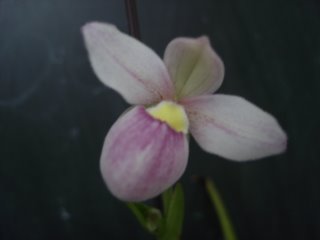
This is my one hundred and first post on the website. To celebrate I've added some new shots of my Phragmipedium schlimii 'Rosy Cheeks'. As you can see on the chalkboard the plant has a leafspan of 11.5", a flower spread of 2", a height of 6" and a pot size of 4.5". Truly miniature! A very faint rosy fragrance is present. I will post more pics as more flowers develop.
Thursday, October 26, 2006
Phragmipedium schlimii
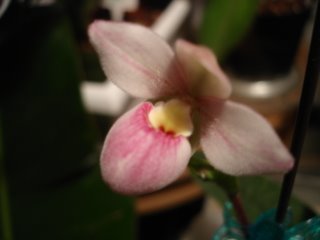 This is a fantastic miniature species from Colombia. Small Phrags are pretty rare, and usually schlimii hybrids are mid-sized or large because the compact size is not dominant. The best part obviously is the flowers, which are not only beautiful but very cute. They have adorable round faces and a fuzzy texture. This little guy is currently about 8" tall with its first flower; the leafspan is about the same. Being a sequential bloomer it will obviously get taller. It has grassy leaves. As it reaches specimen size it will get a little larger leafspan (10-12").
This is a fantastic miniature species from Colombia. Small Phrags are pretty rare, and usually schlimii hybrids are mid-sized or large because the compact size is not dominant. The best part obviously is the flowers, which are not only beautiful but very cute. They have adorable round faces and a fuzzy texture. This little guy is currently about 8" tall with its first flower; the leafspan is about the same. Being a sequential bloomer it will obviously get taller. It has grassy leaves. As it reaches specimen size it will get a little larger leafspan (10-12").Phrag schlimii is a rare collectors item but worth buying if you ever find one. They are not difficult to grow and make good companions with besseae and mottled leaved paphs. Grow the same as besseae; schlimii can take a little higher light and warmer temps. Do not expose to the Cattleya light that larger Phrags like. I grow semi-hydroponically, as I do all Phrags except the drier growers.
Tuesday, October 24, 2006
Fall Show Pic 4: Phrag Sedenii
 This my favorite orchid, the hybrid between Phrag schlimii and Phrag. longifolium. It's an antique hybrid that's hard to find today. I've ordered a division of Phrag schlimii 'Wilcox' AM/AOS from Orchids in Our Tropics; this is actually Sedenii (famously mislabeled) and is obviously superior to the original hybrid.
This my favorite orchid, the hybrid between Phrag schlimii and Phrag. longifolium. It's an antique hybrid that's hard to find today. I've ordered a division of Phrag schlimii 'Wilcox' AM/AOS from Orchids in Our Tropics; this is actually Sedenii (famously mislabeled) and is obviously superior to the original hybrid.
Fall Show Pic 1: Paph Armeni-white
Thursday, October 19, 2006
OS Meeting (Oct) Pic 3: Phrag. longifolium
OS Meeting (Oct) Pic 1: Paph. (chamberlainianum x Pinocchio) x delenatii
Sunday, October 15, 2006
Orchid List As of 10/15/06
Cypripediums
macranthos
reginae 1
reginae 2
Ulla Silkens
pubescens 1
pubescens 2
pubescens 3
pubescens 4
calceolus
parviflorum
Paphiopedilums
delenatii
insigne
Ho Chi Minh
(Joyce Hasegawa x chamberlainianum)
(Claire de Lune x philippinense alba)
(Z4135 x charlesworthii)
(Carticle x Hsinying Maru)
(Ruby Peacock x Hampshire Raven)
(Valerie Tonkin x Maudiae)
[(Yerba Buena x Golden Days) x spicerianum]
Phragmipediums
besseae ('Fire Engine' x 'First Choice')
schlimii 'Abdel'
Ecua-bess
Grande
Hanne Popow
Odontoglossum/Oncidium Alliance
Odontocidium Tiger Crow 'Golden Girl'
Odontonia Memoria Martin Orenstein 'Lulu' HCC/AOS
Odontoglossum Violetta von Holm 'Dominique'
Dendrobiums
Den. kingianum
Unknown seedling
macranthos
reginae 1
reginae 2
Ulla Silkens
pubescens 1
pubescens 2
pubescens 3
pubescens 4
calceolus
parviflorum
Paphiopedilums
delenatii
insigne
Ho Chi Minh
(Joyce Hasegawa x chamberlainianum)
(Claire de Lune x philippinense alba)
(Z4135 x charlesworthii)
(Carticle x Hsinying Maru)
(Ruby Peacock x Hampshire Raven)
(Valerie Tonkin x Maudiae)
[(Yerba Buena x Golden Days) x spicerianum]
Phragmipediums
besseae ('Fire Engine' x 'First Choice')
schlimii 'Abdel'
Ecua-bess
Grande
Hanne Popow
Odontoglossum/Oncidium Alliance
Odontocidium Tiger Crow 'Golden Girl'
Odontonia Memoria Martin Orenstein 'Lulu' HCC/AOS
Odontoglossum Violetta von Holm 'Dominique'
Dendrobiums
Den. kingianum
Unknown seedling
Plants for Sale
DISCLAIMER: This is not an advertisment in any way.
I have a sort of "mini business" at home in which I sell some garden divisions and seed-raised plants of perennials in the spring and fall at my horticultural society's meetings. I am planning to expand my inventory to include orchids in the near future. Currently I am preparing a limited selection of Dendrobium kingianum keikis, and a blooming size Paphiopedilum insigne division. I am also planning some BS Odontocidium Tiger Crow 'Golden Girl' divisions, as well as Cypripedium pubescens BS divisions for sale within the next 14 months or so. All of these will be sold at OS meetings, with the exception of Cyp. pubescens, to be sold at HS meetings.
I have a sort of "mini business" at home in which I sell some garden divisions and seed-raised plants of perennials in the spring and fall at my horticultural society's meetings. I am planning to expand my inventory to include orchids in the near future. Currently I am preparing a limited selection of Dendrobium kingianum keikis, and a blooming size Paphiopedilum insigne division. I am also planning some BS Odontocidium Tiger Crow 'Golden Girl' divisions, as well as Cypripedium pubescens BS divisions for sale within the next 14 months or so. All of these will be sold at OS meetings, with the exception of Cyp. pubescens, to be sold at HS meetings.
OS Meeting October Haul
Today was the October OS meeting. I came home with some amazing and hard-to-find plants on my most wanted list. I also captured some great slipper orchid pics at the show, which I'll post in the near future. Today I acquired:
Paph Ho Chi Minh (delenatii x vietnamense)
Paph delenatii
Phrag Hanne Popow (besseae x schlimii)
Phrag schlimii
Dendrobium seedling (unknown speces/cultivar)
Cypripedium reginae (my second one)
Cyp. macranthos
Paph Ho Chi Minh is a fantastic new hybrid between the famous P. delenatii and the recently discovered P. vietnamense. The huge flowers look like delenatii but have a darker lip. It retains the fragrance and compact habit of both its parents, and has caused a sensation. Mass-produced in the US, it's not easy to get one in Canada, but I got lucky. A bloom-sized seedling for $30.
Paph delenatii is the most well-known Paph species and respresents its group well. It has always been up there on my list. Large pink lip with white tepals (sepals and petals). Beautiful mottled leaves. Bloom-sized mature plant for $35.
Phrag Hanne Popow is a very popular hybrid beween the two most colorful Phrag species. Because both its parents are miniatures, it's a compact plant. It has the shape of besseae with the color of schlimii (light rosy-pink with yellow staminode). A sequential bloomer, it produces up to 10 flowers on a spike. A blooming plant for $25.
Phrag schlimii is a collector's item. It's hard to find and worthwhile, for its delightful rosy-pink flowers with a yellow staminode. Its round shape is reminiscent of our native Cyps. What's more, is it's a full miniature, less than half the size of a caudatum-group Phrag or a (caudatum x besseae) type hybrid. For the most part it grows the same as besseae but likes a fairly coarse medium for Phrags. An in-spike plant for $20 (though fairly small).
Cyp reginae is my favorite Cyp, with its large fuschia lip and white tepals. It forms large, bushy clumps over time. An awesome garden plant. Bloom-sized plants usually are expensive, but my big BS divison (4 growths) was only $25.
Cyp macranthos is a must-have Cyp. An Asian species with large red or pink flowers. Its compact habit makes it great for front-border or rock gardens. Large BS divison (5 growths) for $25.
Paph Ho Chi Minh (delenatii x vietnamense)
Paph delenatii
Phrag Hanne Popow (besseae x schlimii)
Phrag schlimii
Dendrobium seedling (unknown speces/cultivar)
Cypripedium reginae (my second one)
Cyp. macranthos
Paph Ho Chi Minh is a fantastic new hybrid between the famous P. delenatii and the recently discovered P. vietnamense. The huge flowers look like delenatii but have a darker lip. It retains the fragrance and compact habit of both its parents, and has caused a sensation. Mass-produced in the US, it's not easy to get one in Canada, but I got lucky. A bloom-sized seedling for $30.
Paph delenatii is the most well-known Paph species and respresents its group well. It has always been up there on my list. Large pink lip with white tepals (sepals and petals). Beautiful mottled leaves. Bloom-sized mature plant for $35.
Phrag Hanne Popow is a very popular hybrid beween the two most colorful Phrag species. Because both its parents are miniatures, it's a compact plant. It has the shape of besseae with the color of schlimii (light rosy-pink with yellow staminode). A sequential bloomer, it produces up to 10 flowers on a spike. A blooming plant for $25.
Phrag schlimii is a collector's item. It's hard to find and worthwhile, for its delightful rosy-pink flowers with a yellow staminode. Its round shape is reminiscent of our native Cyps. What's more, is it's a full miniature, less than half the size of a caudatum-group Phrag or a (caudatum x besseae) type hybrid. For the most part it grows the same as besseae but likes a fairly coarse medium for Phrags. An in-spike plant for $20 (though fairly small).
Cyp reginae is my favorite Cyp, with its large fuschia lip and white tepals. It forms large, bushy clumps over time. An awesome garden plant. Bloom-sized plants usually are expensive, but my big BS divison (4 growths) was only $25.
Cyp macranthos is a must-have Cyp. An Asian species with large red or pink flowers. Its compact habit makes it great for front-border or rock gardens. Large BS divison (5 growths) for $25.
Sunday, October 08, 2006
OS Meeting Pic 3: Phrag. Hanne Popow
 Phrag. Hanne Popow (besseae x schlimii) is one of my favorite orchids, and I was very fortunate to see it on display at the last OS meeting. What a fantastic speciman! It had at least 10 spikes open! Quite compact, too.
Phrag. Hanne Popow (besseae x schlimii) is one of my favorite orchids, and I was very fortunate to see it on display at the last OS meeting. What a fantastic speciman! It had at least 10 spikes open! Quite compact, too.As for the judging at this mini-show:
The Phrag longifolium var. gracile won "Best Phragmipedium" and this Hanne Popow won "Best Culture". The Armeni-white wasn't a winner; the "Best Paphiopedilum" was Paph. Doll's Kobold 'Sweet Grass', which I unfortunately do not have a pic of.
OS Meeting Pic 2: Phrag. longifolium var. gracile
Orchid Society Meeting Pic 1: Paphiopedilum Armeni-white
Brassia Eternal Wind 'Summer Dream'
 This is my first and only Brassia, which I picked up a couple weeks ago. Brassia are very unique and interesting orchids and you can see why they are often called "spider orchids". Besides being very dramatic, the flowers are quite fragrant. Brassia can grow with Odontoglossums, but prefer a little brighter light.
This is my first and only Brassia, which I picked up a couple weeks ago. Brassia are very unique and interesting orchids and you can see why they are often called "spider orchids". Besides being very dramatic, the flowers are quite fragrant. Brassia can grow with Odontoglossums, but prefer a little brighter light.
Odontonia Memoria Martin Orenstein 'Lulu' HCC/AOS
 This fantastic clone was awarded the prestigous Highly Commended Certificate by the American Orchid Society (Division). It's the only awarded orchid I have, and I'm very proud of it. My Miltoniopsis perished in the heat of July; Odontonias are a little more tolerant of culture inefficiencies such as high temperatures and this one did fine. Odontonia is (Odontoglossum x Miltonia) and as you can see, the flowers resemble those of Miltoniopsis but are smaller with a less-significant-but-still-showy lip. This particular clone is quite floriferous and easy to bloom.
This fantastic clone was awarded the prestigous Highly Commended Certificate by the American Orchid Society (Division). It's the only awarded orchid I have, and I'm very proud of it. My Miltoniopsis perished in the heat of July; Odontonias are a little more tolerant of culture inefficiencies such as high temperatures and this one did fine. Odontonia is (Odontoglossum x Miltonia) and as you can see, the flowers resemble those of Miltoniopsis but are smaller with a less-significant-but-still-showy lip. This particular clone is quite floriferous and easy to bloom.
Sunday, September 24, 2006
Paphiopedilum Parvisepalum Species/Hybrids
I have already passed the level in paph growing where I need to try something new, and my target is Parvis. I have succeeded with Maudiae hybrids, novelties and complex, as well as the species P. insigne. I love parvis, but haven't been able to find any until now. I've finally joined my local orchid society, so my connections have greatly increased. I no longer have to rely on garden centers for orchids; now I can get them from the pros. At my first meeting (where many orchids are sold) I found a Paph. delenatii, a spectacular species with pink and white flowers and my favorite orchid. A previously bloomed plant for $15. As I was examining it and the vendor was ready to sell, a woman came up and said "No sales until one o'clock!". So, I figured I would sort of hang around until then; I walked away for 5 minutes and when I returned the delenatii was gone, and another woman was holding it! That bastard!!! Anyway, though I missed out on that, I still got a bloom-sized Joyce Hasegawa x chamberlainianum. A big multi growth plant for $30. It should bloom within 3 months, and apparently it has big, round flowers in pink or white (multifloral). Just what I like! The leaves are gorgeous - darkly mottled and peppered purple on the undersides. Exciting!
Phragmipedium Grande
 Phrag. Grande (caudatum x longifolium) is the best caudatum-type hybrid in my opinion. Having been bred in the late 1800s, it's tried and true. It has very large, dramatic flowers with a rich mahogany lip, lighter sepals and long, spiralling, purple-pink petals up to a foot long. A mature plant reaches 2.5-3' tall in spike, and it produces 2-6 flowers on a spike which are open more or less at the same time. It will bloom for many weeks in this way. To bloom, it needs high light levels (like a west or south window). This type of phrag is best not grown in water like the besseae types but should be watered frequently. Also, they tolerate tap water better than the besseae types. I bought this plant very recently at a local orchid society meeting for $65.
Phrag. Grande (caudatum x longifolium) is the best caudatum-type hybrid in my opinion. Having been bred in the late 1800s, it's tried and true. It has very large, dramatic flowers with a rich mahogany lip, lighter sepals and long, spiralling, purple-pink petals up to a foot long. A mature plant reaches 2.5-3' tall in spike, and it produces 2-6 flowers on a spike which are open more or less at the same time. It will bloom for many weeks in this way. To bloom, it needs high light levels (like a west or south window). This type of phrag is best not grown in water like the besseae types but should be watered frequently. Also, they tolerate tap water better than the besseae types. I bought this plant very recently at a local orchid society meeting for $65.
Friday, August 25, 2006
Paphiopedilum Z4135 x charlesworthii
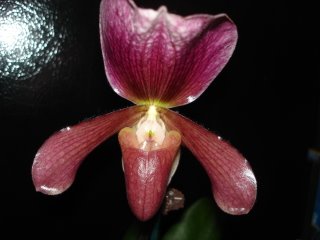 To be honest I have no idea what "Z4135" is but I suspect it's a clone of Maudiae, since this wonderful hybrid has mottled leaves (unlike charlesworthii). The flowers are also a deep purple-red throughout; charlesworthii has more of a tannish pouch and petals, and the petals are smaller (and the pouch is rounder). However the flower retains the veining and spectacular dorsal of charles. I spotted this hybrid in full bloom a couple weeks ago and it's still blooming at home! Charlesworthii is one of my fav paph species and this should hold me until I get one!
To be honest I have no idea what "Z4135" is but I suspect it's a clone of Maudiae, since this wonderful hybrid has mottled leaves (unlike charlesworthii). The flowers are also a deep purple-red throughout; charlesworthii has more of a tannish pouch and petals, and the petals are smaller (and the pouch is rounder). However the flower retains the veining and spectacular dorsal of charles. I spotted this hybrid in full bloom a couple weeks ago and it's still blooming at home! Charlesworthii is one of my fav paph species and this should hold me until I get one!
Phalaenopsis Maki Watanabe

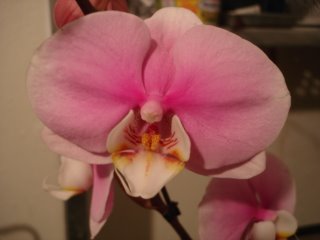
This is my favorite Phal hybrid and the only Phal I actually own. The flowers are 4" across, making it one of the most showy phals. Phalaenopsis are considered the easiest orchid to grow and the best beginner's orchid; personally if you live in a temperate area I think Bletilla are the easiest orchids to grow. Phals though as far as tropical orchids go are the best first orchid, as long as you do not purchase one from a home store... these orchids are usually in rough shape and even if they aren't they are always potted in moss which makes them very easy to overwater and kill for the beginner. Get one from a reputable nursery.
Monday, August 14, 2006
Aconitum henryi 'Spark's Variety'
Strange flower on peacock glad
Chrysanthemum Firecracker 'Suncatcher'
Delphinium Magic Fountains 'Blue and White Bee'
Monarda 'Petite Delight'
Sunday, August 06, 2006
Paphiopedilum (Claire de Lune x philippinense var. alba)

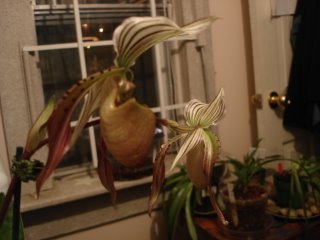 This is an absolutely fantastic plant. It is the only multifloral paph I have, and it looks a lot like philippinense (the original form) but with shorter petals and mottled leaves. The flowers are huge. The best part is, because it has Maudiae in its parentage it not only gets the mottled leaves but it is easier to grow than the philippinense parent. One of the best first multifloral paphs, in my opinion.
This is an absolutely fantastic plant. It is the only multifloral paph I have, and it looks a lot like philippinense (the original form) but with shorter petals and mottled leaves. The flowers are huge. The best part is, because it has Maudiae in its parentage it not only gets the mottled leaves but it is easier to grow than the philippinense parent. One of the best first multifloral paphs, in my opinion.
Lilium lancifolium 'Citronella'
 Lilium lancifolium (syn. L. tigrinum) is the true tiger lily (many people see an orange lily or even daylily and call it a tiger lily!). The real tiger lily is a fantastic plant growing to 4 or even 5 feet tall. The flowers are smaller than other lilies but much more numerous; my plants are young and each produced around 15. Of course they are ususally orange with black spots; the cultivar 'Citronella', pictured here, is yellow. A pink cultivar is also available. They all have strongly reflexed petals/sepals. This was the very last flower left on one of my three plants when I returned home; I photographed it just before it too fell off! For next year I'll be hunting for the original and the pink variety.
Lilium lancifolium (syn. L. tigrinum) is the true tiger lily (many people see an orange lily or even daylily and call it a tiger lily!). The real tiger lily is a fantastic plant growing to 4 or even 5 feet tall. The flowers are smaller than other lilies but much more numerous; my plants are young and each produced around 15. Of course they are ususally orange with black spots; the cultivar 'Citronella', pictured here, is yellow. A pink cultivar is also available. They all have strongly reflexed petals/sepals. This was the very last flower left on one of my three plants when I returned home; I photographed it just before it too fell off! For next year I'll be hunting for the original and the pink variety.
I'm Back!
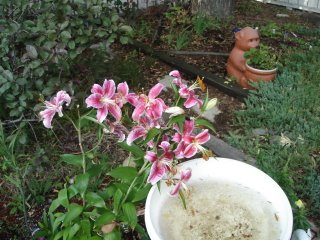

Well I've been vacationing on Vancouver Island for the past 3 weeks but I'm back now, and wow has my garden changed! Pictured here is Lilium orientalis 'Stargazer', my favorite lily. I have a clump with 8 stems plus a seperate single-stemmed plant. Unfortunately by the time I got back they were pretty much done but there were still a few flowers left. I completely missed my L. orientalis 'Casablanca' (damn it!), which has pure white flowers. All of these Oriental lilies have an amazing fragrance.
Thursday, July 13, 2006
Lilium 'Pink Perfection'
Alcea 'Chater's Double Pink'
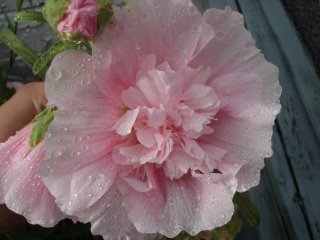 Hollyhocks are fantastic sun plants and their height of 8' can yield many uses. They make very good cutflowers. The Chater's Double Group selections resemble roses and come in many different colors. Remember that Alcea are biennials and must be replaced after two years. Start seeds every year so you always have fresh stock to plant. They are very easy from seed.
Hollyhocks are fantastic sun plants and their height of 8' can yield many uses. They make very good cutflowers. The Chater's Double Group selections resemble roses and come in many different colors. Remember that Alcea are biennials and must be replaced after two years. Start seeds every year so you always have fresh stock to plant. They are very easy from seed.
Monarda 'Marshall's Delight'
Ratibida
Echinacea purpurea 'Razzmatazz'
Nepenthes ventricosa
Lilium regale
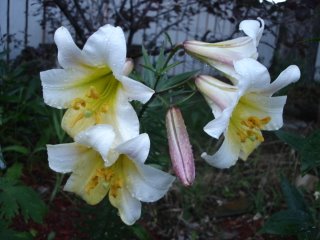 I may have mentioned this before, but I love lilies (my favorite non-orchid plants), and I'm trying to collect as many as I can this year. This trumpet lily species is a classic, with a baby powder-like scent that fills the entire garden with freshness and enchantment. It has performed well from a newly-purchased bulb this spring, reaching 3' in height and producing five full-sized flowers.
I may have mentioned this before, but I love lilies (my favorite non-orchid plants), and I'm trying to collect as many as I can this year. This trumpet lily species is a classic, with a baby powder-like scent that fills the entire garden with freshness and enchantment. It has performed well from a newly-purchased bulb this spring, reaching 3' in height and producing five full-sized flowers.
Corydalis flexuosa 'China Blue'
Gaillardia 'Goblin'
Gaillardia 'Goblin'
Subscribe to:
Posts (Atom)





